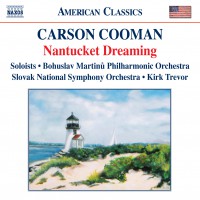Opus 710
Lyric Trio for Trumpet, Cello, and Piano (2007)
for Trumpet, Cello, Piano
- Red Darkness
- The Thousand Candles
- Windswept
- Whispering Wings
- Towards Light
- Let Evening Come
Duration: 19 min.
Dedication: for Colby Cooman, Chris Gekker, and the Orenunn Trio
Commission: Commissioned by The Commission Project
 Recorded on Carson Cooman: Nantucket Dreaming (2010)
Recorded on Carson Cooman: Nantucket Dreaming (2010)Publisher: Musik Fabrik
Performance materials available from the publisher.
Lyric Trio for Trumpet, Cello, and Piano (2007) was commissioned by The Commission Project of Rochester, New York (Ned Corman, director). The work was brought about through the inspiration of a consortium comprising Colby Cooman, Chris Gekker, and the Orenunn Trio.
The work is cast in six movements. The spirit behind the work is one of an “American travelogue”—with each movement taking inspiration, colors, and rhythms from sounds and landscapes throughout America. In many cases, the inspirations are not single specific places, but “types” of places that can be found in many locales. They are thus not labeled specifically, for the spirit of the contemplations is more general.
The overall tone throughout is one of singing lyricism—a sense of “songs without words” pervades much of the writing. Melodic lyricism takes all sorts of forms in this work, ranging from long-breathed melodies to shorter, more fragmentary ones.
Red Darkness begins the work with blazing color. Focused repetitions of pitches continue to dissolve into lyrical, yet tense, interludes.
The Thousand Candles is a passionate meditation on the trumpet’s opening melody.
Windswept is a brief scherzo and flies by quickly.
Whispering Wings begins slowly and spaciously. A more active middle section interrupts before the opening material returns, though this time with a bit more momentum.
Towards Light is a vibrant spark of energy—with a bit of the spirit of a barn dance.
Let Evening Come takes it title from a poem of American poet Jane Kenyon (1947–95). A spirit of lyrical acceptance in the midst of a vivid landscape pervades this movement, which draws the work to a contemplative, yet affirmative close.
